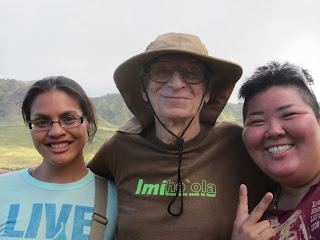

 “Rather than building up for war, we could be working toward peace,” Fred Dodge, MD, co-founder of Mālama Mākua.
“Rather than building up for war, we could be working toward peace,” Fred Dodge, MD, co-founder of Mālama Mākua.Wanting to connect with ‘āina before leaving for Vieques, Eri, Elise and I had the opportunity to visit Mākua Valley.
Mākua once supported a thriving community. It is a traditional training ground for ‘olohe, masters of the warrior arts, and, because of the long stretch of sandy beach, it was a comfortable stopping off point for visitors destined for Kaena Point. There were terraces of dryland crops; uala, sweet potato, was probably the primary one.
When the U.S. entered World War II, the Army appropriated Mākua for live weapons training. The valley was assaulted from land, air and sea. Up through 1998, Mākua valley was used as a disposal site for unneeded ordnance and other hazardous materials. Only in 2004 did live weapons training end.
Due to the grassroots efforts to honor Mākua valley as a wahi pana, Mālama Mākua has emerged as the stewardship organization that serves as watchdog, monitor, liaison to the Army, and kahu 'aina. Training is more controlled, culturally significant sites are preserved and studied, and there’s a big endangered species conservation effort in place.
But it’s a never ending job for Mālama Mākua – they are disputing an incomplete environmental assessment of the marine resources, battling the Army’s renewed claim to the valley as a necessary training ground, while also negotiating for regular, cultural accesses.
Looking to Kaho‘olawe as a model, Mālama Mākua has in its arsenal some of the United States’ own laws: the Endangered Species Act, the Historic Preservation Act, the Environmental Policy Act, and, most importantly, the American Indian Religious Freedom Act (AIRFA). It is the latter that will assure access to the community to mark the opening and closing of Makahiki, and regular access to several culturally significant sites throughout the valley.
Upon arrival, our ho‘okupu to Mākua included wai from the punawai deep in Nu‘alolo ‘Āina, and pa‘akai from Hanapēpē. Fred and Leandra welcomed us. With us were a few kūpuna, a group of hiking grad students, and two of the three founders of Nā Wāhine o Kunia Honouliuli. We saw petroglyphs, terraces and waterways (sans the water). We learned about mauka conservation efforts and different historic uses of the areas we saw and visited. We felt the nurturing spirit of Mākua.
Mahalo iā Ko‘iahi, mahalo iā Kahanahāiki, mahalo iā Mākua!
(c) Kim Ku‘ulei Birnie







No comments:
Post a Comment
Note: Only a member of this blog may post a comment.